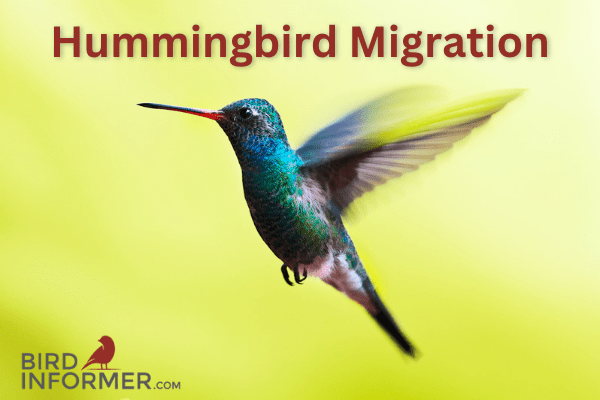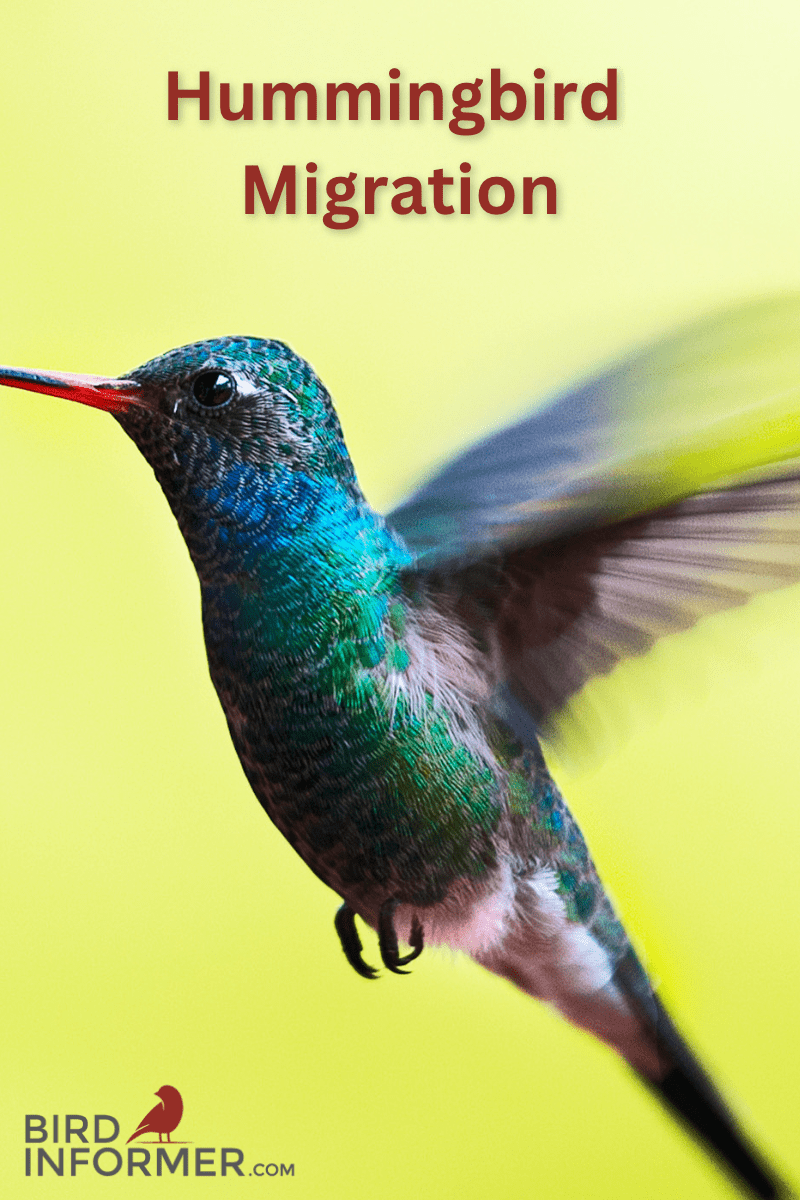Contents
Are you trying to figure out where hummingbirds migrate to during the winter? Do they even migrate at all? We’ll answer your most pressing and important questions below.
Most hummingbirds in North America fly to Central America or Mexico before winter really settles in. When compared to warblers that migrate in South America, their journey isn’t nearly as long. But hummingbirds are diminutive in size, so flying 18-24 hours in good or bad weather is quite impressive.
Would you like to discover even more information about hummingbirds and their migration habits and patterns? You’ve definitely found the perfect website to answer your questions and alleviate your concerns.
Throughout the rest of this piece, I will cover the following topics about hummingbird migration and more. They include:
- Which hummingbirds migrate during the year
- The distance and destinations of migrating hummingbirds
- Why hummingbirds migrate
- Key facts about hummingbirds
- When to take down hummingbird feeders
- and much more
To learn more about hummingbird migration and other related topics, continue reading this information below.
According to American Bird Conservancy, “although hummingbirds occupy most of North America during summer months, these tiny birds remain tropical at heart and most do migrate. The main exception is the Anna’s Hummingbird, which stays put all year along the Pacific Coast.”
Anna’s Hummingbird isn’t the only bird to mostly stay put. Although, the other hummingbirds in question tended to live in other parts of the world in Mexico and Central America.
Are you wondering which hummingbirds migrate during the year? Would you like to learn more about where they migrate to? We’ll answer these questions and more below.
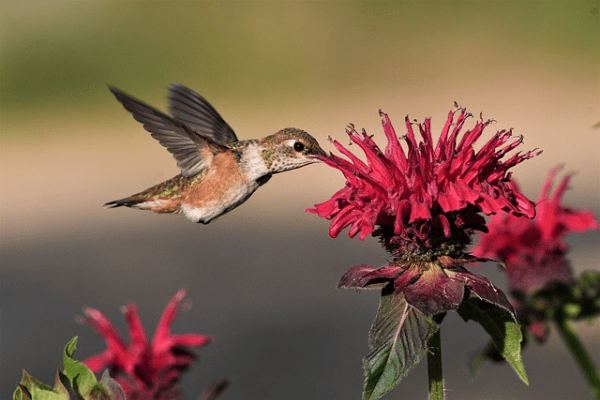
Hummingbirds: Which Ones Migrate During the Year?
Here are the facts:
Lucifer Hummingbird
Lucifer Hummingbirds live all year-round in Mexico in the central plateau. Although at times, they will migrate for short distances.
During the fall migration in September, and again during the spring migration beginning in March, a tiny population of these hummingbirds will leave their homes and fly to Northern Mexico or the southwestern part of the United States during breeding season.
During the winter, these birds will once again begin to travel and make their way back toward central Mexico, where the weather is warm all year-round.
Birdwatchers might spot them between March and September in western Texas, New Mexico, or the border of Arizona.
Calliope Hummingbird
The Calliope Hummingbird tends to migrate along the Pacific Coast during the spring and goes north. In the fall, it will start heading back down south by traveling along the Rocky Mountains.
During the summer, the Calliope Hummingbird will spend its time in parts of Northwestern United States and British Columbia. It starts heading south in late August or early September before the weather begins to get really cold.
If you’re in the Rocky Mount region during September, it’s a great time to enjoy the presence of the Calliope Hummingbird as they are migrating through the area. Typically, the majority will have already crossed the border into Mexico at the end of October.
During the winter, they spend their time in the Mexico City area of Central Mexico. They also enjoy the Colima and Puerto Vallarta regions along the western coast.
Broad-Billed Hummingbird
The Broad-Billed Hummingbird can only be found in two different states within the United States of America with any measure of regularity. In this instance, this bird tends to stick to New Mexico and Arizona.
The bulk of this Hummingbird species spends its time all year-round in central and western Mexico. But it is known that a small portion of their population will cross over the US border into the southwestern United States during the year.
Typically, these birds can be cited in southeastern Arizona or the Tucson or Phoenix areas. Their migration season isn’t easily defined, so it’s hard to pinpoint when you might find them in these regions. More than likely, you’ll find the broad-billed Hummingbird in Arizona throughout the spring and summer months.
Have You Ever Wondered If Hummingbirds Can Fly In The Rain?
Don’t Be Fooled By Their Size – Hummingbirds Are Tough Birds. And Yes, They Can Fly In The Rain. Click The Button Below To Learn How!
Broad-Tailed Hummingbird
The Broad Tailed Hummingbird breeds at high elevations over 10,500 feet and loves spending time in the mountains. This bird will spend its summers in the western portion of the United States along the Rocky Mountains in areas including California, Utah, and Arizona.
They do not spend their winters here and choose to go south beginning in late August or early September, where they begin to head toward Mexico.
For the most part, it will spend the bulk of its winter in Central Mexico. On occasion, there are certain members of the population that will even go further south into Guatemala. A small portion of the population will also remain in the US during the winter in the southeastern part of Arizona, or the Gulf coast of Louisiana and Texas.
They begin heading back toward the Rocky Mountains each year starting in April and May.
Allen’s Hummingbird
Allen’s Hummingbird visits the United States during the summer, but it likes to stick to a very small location within the Pacific Coast. Typically, this Hummingbird tends to remain in Southern Oregon and California, along the shore.
During the late summer, it will begin to fly to Central Mexico by heading south and remain in the Mexico City area during the winter. Some of these birds like to head south as early as July, but they tend to do so in August.
Oddly enough, there is a small area in the Channel Islands and Los Angeles where Alex Hummingbird will stay all year-round. Once the winter is over, this bird will begin migrating north along the Pacific coast as early as February-March.
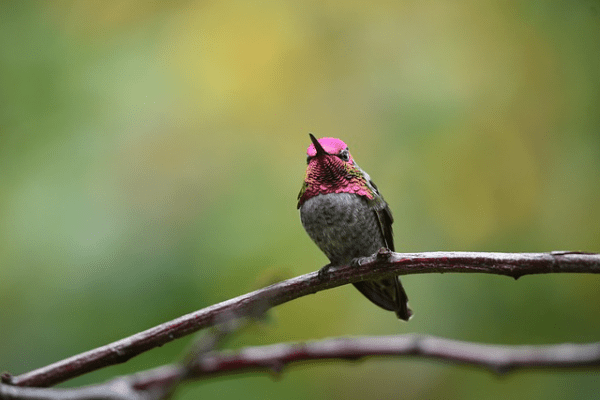
Black-Chinned Hummingbird
The Black-Chinned Hummingbird spends time in the United States in the western portion of the country. Their common breeding grounds include a number of states like Colorado, California, Oregon, Arizona, Utah, Montana, Texas, Idaho, Washington, Nevada, Wyoming, and New Mexico.
But just like most other hummingbirds, they will migrate south during the winter and head toward Mexico to enjoy the sunny winter weather.
They’ll leave the northern areas in September and nearly every Hummingbird is gone from the states in the North by October. They’ll leave the rest of the summer range by November and head toward the wintering grounds in Mexico.
While in Mexico, they tend to enjoy the western coasts including Puerto Vallarta. Although there are some black-chinned hummingbirds that will remain along the Gulf Coast of Florida, Louisiana, and Texas during the winter. By March, many of these birds start heading north and the bulk of their population is at its summer range by as late as April.
Rufous Hummingbird
The Rufous Hummingbird travels very long distances during its migratory periods. It spends its summers in the Pacific Northwest in parts of Montana and Idaho, Oregon and Washington. It also spends its summers in southern Alaska and the West Coast of Canada.
It will leave Canada and Alaska in early July during the migration. And head toward the wintering grounds of the Gulf Coast or Mexico and get there by October.
The Rufous Hummingbird will travel round-trip from southern Alaska to Mexico by nearly 4000 miles each year. If they choose to winter in the United States, they will remain along the Gulf Coast in the Florida Panhandle, Louisiana, and Texas.
Ruby-Throated Hummingbird
The Ruby-throated hummingbird is another long-distance migratory bird that commonly occupies the eastern portion of the United States. Many Ruby hummingbirds spending time in Canada will travel as much as 2000 miles to reach Central America and their wintering grounds.
During the fall, this bird will head South and cross the Gulf of Mexico or travel through Texas along the eastern coast. It leaves the northern states by mid-September and is typically all the way south by the time October ends.
Few of these birds remain in the United States during the winter. But when they do, they tend to remain along the Gulf Coast of southern Florida or the coastal Carolina states. If this bird does decide to stay in the US during the winter, typically it’s because it came furthest north from Canada.
Buff-Bellied Hummingbird
The Buff-Bellied Hummingbird generally remains within its typical stomping grounds all throughout the year. All year long, you can find this bird in Mexico along the entire eastern coast. It also heads into Guatemala and northern Belize.
This population remains here year-round and extends from the Mexican border up until the southeastern portion of Texas, typically in the Corpus Christi area.
While there are a few buff-bellied hummingbirds that live in Texas, they typically do go south for the winter and head into Mexico. There is a small population of these birds that will go past Houston and head into Louisiana.
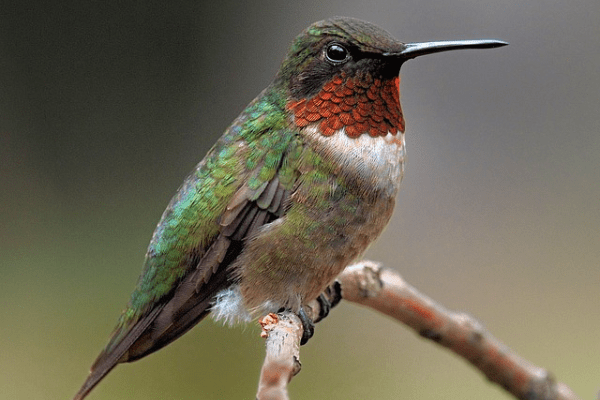
Rivoli’s Hummingbird
Rivoli’s Hummingbird is not a common bird species living in the United States, although you can find them in small pockets in the Southwest. They occasionally cross the border and visit the United States from Mexico.
The year-round home of Rivoli’s Hummingbird is in Central America and Mexico. Their home extends as far in the South as Nicaragua.
Although this bird doesn’t really migrate, it will perform short migrations along local valleys and mountain ranges.
It’s possible for birdwatchers to find this Hummingbird species in southeastern Arizona. More often than not, if they do cross over into the United States, it tends to happen between April and September. Or if you’re lucky, you may find them in the southeastern part of New Mexico as well, but this is rare.
Costa’s Hummingbird
Costa’s Hummingbird is a memorable site to hold because it has beautiful purple throat feathers that flare and look amazing. But as far as their presence in the United States is concerned, you’ll only find them in a small section of Southern California, although they remain there year-round. Besides Southern California, they also live in the southwestern Arizona, along the Baja Peninsula, and in the northwestern part of Mexico.
Part of the population will travel to the west coast of Mexico by heading further south during the winter. Still, some will branch out even further into Southern Nevada and Arizona during the summertime.
You’ll find these hummingbirds in the Mojave and Sonoran deserts in the southwestern United States between February-May. Nevertheless, you can even find them in San Diego and Los Angeles during the winter.
Anna’s Hummingbird
Anna’s Hummingbird is very different from most North American hummingbirds because it doesn’t travel a great distance during migration. In fact, this Hummingbird remains in the western part of the United States and often tends to stay there throughout the year.
It will travel short distances at times, but it only tends to do so when it’s looking for food sources in greater abundance.
This bird is a resident all year-round in Arizona, California, Oregon, and Washington. Small parts of their population will spread out to Baja, Northeastern Mexico, New Mexico, and Canada’s West Coast throughout the winter.
Hummingbird Migration Information
| Name | Distance | Fall Migration | Spring Migration |
| Lucifer Hummingbird | Short Distance | September | March-May |
| Calliope Hummingbird | Long Distance | August-September | March-May |
| Broad-Billed Hummingbird | Resident, Short Distance | September | March |
| Broad-Tailed Hummingbird | Medium Distance | August-September | April-May |
| Allen’s Hummingbird | Resident, Medium Distance | July-September | February-April |
| Black-Chinned Hummingbird | Medium to Long Distance | September-October | March-April |
| Rufous Hummingbird | Long Distance | July-September | January-March |
| Ruby-Throated Hummingbird | Medium to Long Distance | September-November | March-May |
| Buff-Bellied Hummingbird | Resident, Short Distance | N/A | N/A |
| Rivoli’s Hummingbird | Short Distance | N/A | N/A |
| Costa’s Hummingbird | Resident, Short Distance | N/A | N/A |
| Anna’s Hummingbird | Resident, Short Distance | N/A | N/A |
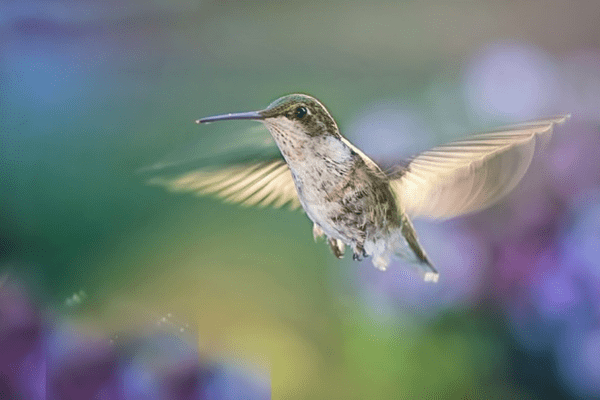
Why Do Hummingbirds Migrate?
According to AZ Animals, “During the late summer and fall, when the days begin shortening, hummingbirds make their long journey south. These birds are highly tolerant of cold weather, so decreasing temperatures is not typically their reason for leaving their environments.”
The reasons hummingbirds migrate include:
- Inadequate food supply
- Breeding grounds are far away
- Lack of nourishment during the winter in the US
- An abundance of insects and flowering plants in southern regions
Hummingbird Migration Facts
- Hummingbirds leave their summer grounds during the late portion of the summer or early portion of the fall.
- These birds tend to migrate and make their trips to the South because their food supplies become scarce during the freezing winters.
- Plummeting temperatures aren’t their reason for migrating.
- With the arrival of spring and summer, competition for food sources including insects and nectar reaches an all-time high, which is why hummingbirds will head north once again for easier access to food sources
When Is the Ideal Time to Take Down Hummingbird Feeders?
According to hummingbirdcentral.com, “During the fall migration, it is recommended that Hummingbird lovers leave up their feeders for about two weeks after they sighted their final bird. Just to feed those late migrating hummers!”
Makes sense, right?
You don’t want any of your favorite hummingbirds to starve as the weather begins getting cold. So, absolutely make sure all of the hummingbirds in the vicinity of your home are gone before you take down your feeders for the winter. This ensures that every hummingbird will have delicious meals and tasty treats available immediately before heading south for the winter.

